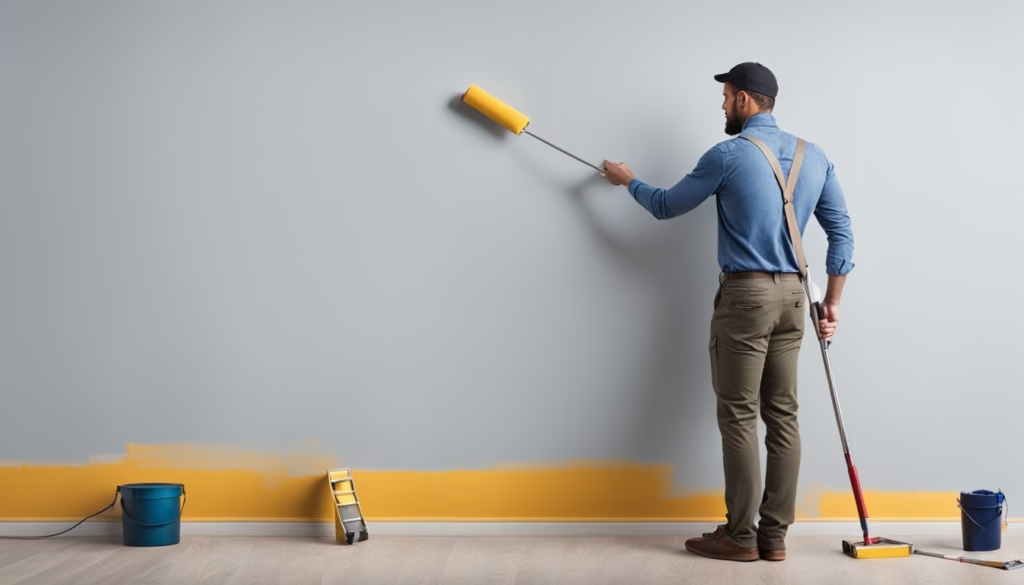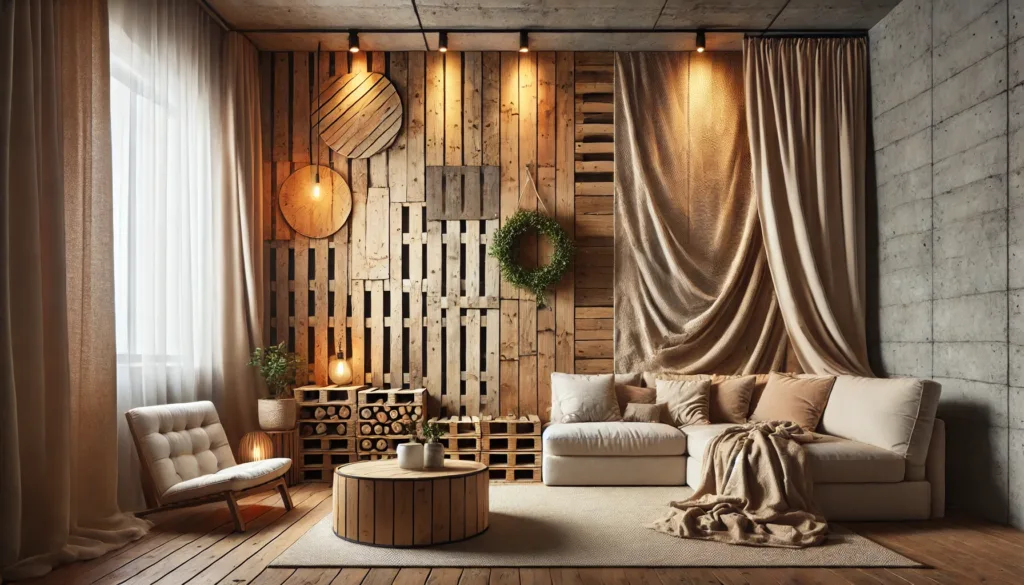Imagine walking into your rental home, a place meant to be your sanctuary. Yet, the dull white walls seem to block your creativity. You feel the strong urge to add some color, but you’re unsure about your rights. It’s important to know, can a tenant paint interior walls to make space his own while following his lease rules.
This guide will clear up the confusion on tenant painting rights. It will explain why you might want to paint and why getting your landlord’s okay is key. Knowing what you can do will make renting easier and more enjoyable for you.

Key Takeaways
- Many tenants wish to personalize their space through painting.
- Understanding your tenant painting rights is crucial.
- Always seek landlord permission for painting to avoid penalties.
- Knowledge of state laws and lease agreements influences your options.
- Ensure you follow proper procedures for a smooth painting experience.
Understanding Your Tenant Painting Rights
As a tenant, knowing your rights about painting and altering your rental space is key. These rights can change a lot based on state laws, lease agreements, and property rules. It’s important to understand these to live comfortably in your home.
Overview of Tenant Rights
Your main rights as a tenant let you enjoy your home without too much trouble. But, there are limits. These come from lease agreements and property rules on how much you can change things, like painting walls. Knowing these limits helps you protect yourself and your home.
Legal Protections for Tenants
Many housing laws protect tenants from landlords who unfairly limit their rights. These laws vary by state, so it’s important to know the ones that apply to you. With this knowledge, you can stand up for your rights, making sure any changes you want, like painting, are legal.
| Aspect | Description |
|---|---|
| Tenant Rights | Rights that allow for enjoyment and use of rental property. |
| Tenant Protections | Legal frameworks that shield renters from unfair practices. |
| Housing Laws | Laws governing landlord-tenant relationships and property use. |
| Lease Agreements | Contracts outlining specific rights and limitations. |
Can a Tenant Paint Interior Walls?
Deciding if you can paint interior walls while renting is tricky. It’s key to know when painting might be okay. Landlords often have rules about painting that can be flexible. But, always get permission to paint to avoid problems.
Common Scenarios Where Painting is Allowed
Here are times when painting might be okay:
- You can do minor touch-ups to fix wear and tear.
- Some landlords let you make changes if you tell them first.
- They might say yes if you want to make the space your own, with their okay.
Potential Consequences of Painting Without Permission
Painting without permission can cause big problems:
- You might lose your security deposit if the paint doesn’t match the rental rules.
- You could be charged to repaint the walls back to their original color when you leave.
- Unapproved changes can make things awkward with your landlord.
Importance of Landlord Permission for Painting
Getting permission from your landlord before painting is key to a good tenant-landlord relationship. Many tenants want to make their space their own, but landlords have rules. Knowing why these rules exist can help you ask for permission the right way.
Why Landlords May Restrict Painting
Landlords might not let you paint for a few reasons, including:
- Property Value Maintenance: Wrong colors or bad painting can lower the property’s value.
- Damage Prevention: Some paints can harm walls, leading to expensive fixes.
- Uniformity: Landlords like their properties to look the same.
- Inspection Requirements: Inspections might ask for certain conditions to be met.
How to Request Permission
Being clear and professional when asking for permission is important. Here are steps to follow:
- Draft a Formal Request: Explain you want to paint and share your color and material choices.
- Highlight Benefits: Show how painting will make the property look better and possibly increase its value.
- Propose a Schedule: Tell the landlord when you plan to start and finish the painting.
- Provide Assurance: Tell the landlord you will pay for everything and fix any damage if needed.
Painting Rental Property Rules
It’s important for tenants to know how state laws and lease agreements work together when painting their rental property. Each state has its own rules about what tenants can change in their homes. It’s key to understand how these laws fit with your lease.
State Laws vs. Lease Agreements
State laws on painting rental properties can be quite different. Some states let tenants make changes easily, while others have strict rules. Lease agreements also play a big part in what you can do with painting. Here’s a quick look at the differences:
| Aspect | State Laws | Lease Agreements |
|---|---|---|
| Modifications Allowed | Variable by state; some permit non-permanent changes | Often specify painting permissions before any action |
| Color Choices | May not restrict; you must check local laws | Can limit to approved palettes |
| Professional Work | No requirement unless specified | May require hiring licensed professionals |
What Rules Might Be in Place
When painting your rental property, you’ll likely run into some rules. These can include:
- Rules on wall colors to keep the look consistent.
- Need to get approval before starting the painting.
- Must use certain types of paint, like non-toxic ones.
- Must put walls back to original color when you move out.
Knowing about state laws and your lease helps you follow the rules. This way, you can make your home your own without breaking any rules.
Understanding Painting Lease Agreements
Before you start painting your rental, it’s key to know about painting lease agreements. These agreements set the rules for making changes like painting in your rental. Knowing what the lease says can help you negotiate better with your landlord.
Typical Clauses Regarding Painting
Most leases have rules about painting. These rules cover things like:
- What colors and types of paint you can use
- The quality of work and when it must be done
- How to fix walls back to their original state when you leave
- Getting your landlord’s okay before you start painting
Knowing these rules helps you talk to your landlord and make smart choices about your rental’s look.
Negotiating Changes to Your Lease
Talking to your landlord about lease changes can let you make your home your own. Many tenants don’t like to do this, but it’s important. Here are some tips for talking to your landlord:
- Make a detailed plan of what you want to paint and the colors you’ll use.
- Offer to pay for the painting yourself to show you care about the property.
- Propose hiring a professional painter to make sure the work is top-notch.
- Ask for a written agreement that spells out any new rules for painting.
Using these negotiation tips, you might get to paint your way and keep a good relationship with your landlord.
Tenant Painting Responsibilities
When you paint in a rental property, knowing what you must do is key. Taking good care and cleaning up after painting keeps the property in good shape. It also helps avoid problems with your landlord when you move out. Being informed makes moving out smoother and keeps things positive with your landlord.
Proper Care and Cleanup After Painting
After painting, focus on cleaning up right. This means cleaning brushes and rollers and dealing with any paint spills quickly. Here’s how to clean up responsibly:
- Remove painter’s tape while the paint is still wet to prevent it from peeling.
- Clean all painting tools well to make them last longer.
- Throw away paint leftovers the right way to protect the environment.
- Check the walls for any touch-ups to make sure they look good.
Dealing with Walls After Moving Out
Painting before you leave might be needed by your lease. To keep your security deposit safe, follow these steps:
- Look at your lease to see what it says about wall color and fixing things up.
- If needed, repaint walls to their original color before the landlord checks them.
- Take pictures of your walls after you’re done to prove their condition.
- Tell your landlord about any damage that happened because of normal wear and tear.

Tips for Interior Painting in a Rental Home
Painting your rental space can make it look fresh and show off your style. But, picking the right paint color selection and using professional painting techniques is key. This ensures your work looks great and meets your landlord’s rules.
Choosing the Right Paint Colors
Choosing the right paint colors can make your home welcoming. Keep these tips in mind:
- Think about the room’s natural light, as it changes how colors look.
- Go for neutral colors if you might repaint before leaving.
- Pick colors that match your furniture and decor for a unified look.
- Try samples on walls first to see the color in your space.
Painting Techniques for a Professional Finish
Using the right painting techniques can greatly improve your rental home’s look.
- Clean and fill holes or cracks for a smooth finish.
- Use top-quality brushes and rollers for even coverage.
- Do the cut-in method along edges first, then roll the rest.
- Let each coat dry before adding more for the best look.
| Paint Color | Room Type | Light Effect |
|---|---|---|
| Soft Gray | Living Room | Brightens in sunlight |
| Muted Blue | Bedroom | Creates a calming effect |
| Warm Beige | Kitchen | Inviting and cozy |
| Pastel Green | Bathroom | Refreshing and clean |
| Bold Charcoal | Home Office | Modern and sophisticated |
Think carefully about your paint color and painting methods to make your rental home look great. Follow your landlord’s rules while showing off your unique style. Aim for a space that’s both beautiful and reflects your personality.
Painting Restrictions for Tenants
When you rent a property, knowing the painting rules is key to a good landlord-tenant relationship. These rules can change a lot from one place to another. They affect how you can make your space your own. Learning about these rules can prevent problems later.
Types of Restrictions Commonly Imposed
Landlords set certain painting rules. Here are some common restrictions you might see:
- Rules about the colors you can use, often sticking to neutral shades or needing approval for bright colors.
- Rules against wallpaper or textured paint that could harm the walls.
- Requirements to use specific paints, like low-VOC ones, for health reasons.
- Rules to put walls back to their original look when you move out.
Consequences of Breaking Painting Rules
Ignoring these rules can have big consequences. If you break the painting rules, you might face:
- Money taken out of your security deposit.
- Extra fees for fixing the walls back to how they were.
- Claims for damages if your changes hurt the property.
- Legal action if you break the lease.

Knowing these rules makes renting smoother and protects your right to enjoy your home. It also respects your landlord’s property. Always check your lease for the painting restrictions for tenants that apply to you.
Communicating with Your Landlord
Talking to your landlord about painting your rental is key. It helps set clear rules and makes things easier for both of you. Always keep track of all messages about painting. This makes things clear and can help solve problems later.
Documenting Requests and Responses
It’s important to keep a record of your painting requests and what your landlord says. Use email or certified mail for your requests. These methods prove you tried to communicate and help avoid misunderstandings.
Building a Positive Relationship
Being respectful and open with your landlord is the first step to a good relationship. Be polite when asking to paint and think about how it affects your landlord. Trust and understanding make it easier to talk about painting and other changes later. A good relationship makes renting better for you.
FAQ
Can I paint the interior walls of my rental unit without permission?
No, you usually can’t paint the walls of a rental without your landlord’s okay. Always check your lease and talk to your landlord before painting to avoid problems.
What are my tenant painting rights?
Your painting rights depend on your lease and local laws. You can enjoy your space, but you often need your landlord’s okay for painting. This ensures you follow property rules.
What are the consequences of painting without permission?
Painting without permission can lead to losing your security deposit or being billed for repainting. It’s key to know your lease’s painting rules.
How should I request permission to paint?
Write a formal request to your landlord explaining the changes you want to make. This can improve your relationship with your landlord and might get you approval.
Are there state laws regarding painting in rental properties?
Yes, state laws affect your painting rights in rentals. Make sure you know your lease and local laws to see what you can do.
What should I do after painting?
After painting, make sure to clean up properly. Many leases say you must return walls to their original color when you leave, so remember this.
Can I negotiate painting clauses in my lease?
Yes, you can talk about painting in your lease. It’s smart to discuss painting with your landlord, especially if you have certain colors or changes in mind.
What are common painting restrictions for tenants?
Common rules might limit your color choices, the paint types you can use, or big changes. Knowing these rules helps avoid disagreements.
How can I build a positive relationship with my landlord regarding painting?
Keep all your requests in writing and talk clearly with your landlord. A respectful relationship can make it easier to discuss future changes.
What techniques can I use to achieve a professional finish when painting?
For a pro look, prepare surfaces well, pick the right paint, and use quality tools. These steps will make your rental look great and follow your lease.

